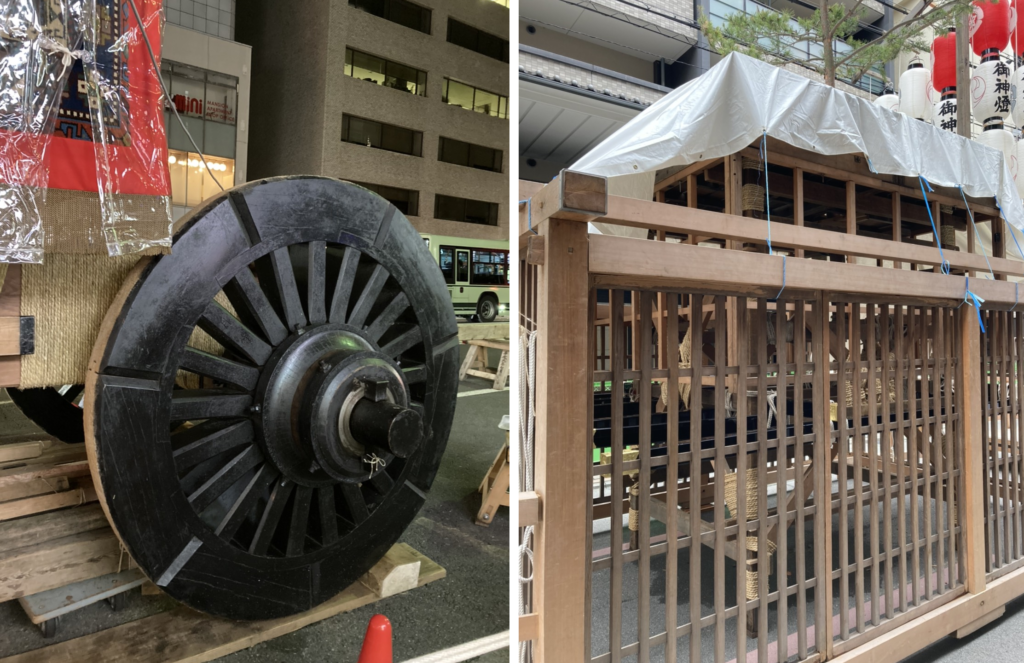Hello, this is Shinji from Warashibe-choja.jp. On July 16th, I went to Kyoto to hear the story of a potter’s teacher. The day before Yamaboko-jyunko is called “yoi-yama” in Gion matsuri. Every year, many people can’t walk, but due to the influence of COVID-19, there were few people and I could take pictures. This time, there are three major festivals in Japan, “Kanda Matsuri” in Tokyo, “Tenjin Matsuri” in Osaka, and “Gion Matsuri” in Kyoto. I would like to talk about one of them, “Gion Matsuri”.
Matsuri = festival?
Speaking of Matsuri, it is translated as Festival in English. Speaking of Festival, I feel a gorgeous image. There are many festivals in Japan to celebrate a good harvest, but “Gion matsuri” was originally born in 869 as a matsuri that gathers and worships evil spirits by setting up 66 Hoko (= halberds) in order to calm the plague during the Heian period. Gion Matsuri is not a gorgeous festival. It is a matsuri where you can hear a little lonely music called Gion-bayashi.
When is Gion Matsuri?

Gion matsuri will be a one-month matsuri from Kippuiri on July 1st to Ekijinjya-nagoshisai on July 31st. It is said that you can get rid of evil by visiting Kyoto during that period. Every year, Yoiyoi-yama on July 15th, Yoi-yama on 16th, and yamaboko-jyunko on 17th show the most excitement. Departing from Shijo Karasuma at 9 am on the 17th, it will take 2 hours to walk around the town center. The beginning is always “Naginata-boko”, and “Shimenawa-kiri” performed by Chigo (= a child who is said to have special powers related to temples and halberds) of Naginata-boko. In “Kuji-aratame” performed by Bugyo (= representative), the order in which each Hoko turns is decided. By the way, the average height of Yama-boko is about 15m and the maximum is 25m, so there is no electric wire on the road in Kyoto city where Yamaboko-jyunko is performed. Fold the traffic light for Yamaboko-jyunko. After that, Yamaboko enters Yasaka Shrine.

At Jinko-sai on the night of the 17th, three portable shrines will travel around the city from Yasaka Shrine and will be placed at Otabi-syo in Shijo Teramachi for 7 days. After that, I will return to Yasaka Shrine again at Kanko-sai on the 24th. In addition to Jinko-sai and Kanko-sai, we also recommend Byobu-matsuri from July 14th to 16th and 21st to 23rd as other events. Yamaboko-cho’s old house and long-established store will decorate and open the collection of art and furnishings. Although the number has decreased recently, the spirit of keeping tradition and hospitality is still cherished.
About Yama and Hoko
Yama and Hoko in the city of Kyoto will be built from July 10th to 14th. At that time, I don’t use any nails. Regarding the difference between Yama and Hoko, “Yama” has “Shin-matsu” (= pine) growing on the roof.

“Hoko” is not a pine tree, but a 20m stick called Shingi. The symbol of Hoko is displayed on “Hoko-gashira” at the end of the stick. Naginata-boko is decorated with Naginata (= long sword), and Tsuki-boko is decorated with Tsuki (= moon).

In addition, Hikiyama has wheels, and Kakiyama is like a portable shrine so that it can be carried.

Hoko is also decorated with Nishijin-ori like a kimono obi, so it would be interesting to look around one by one.

Gion matsuri’s funny custom
In Kyoto, there are some places where the custom of not eating “cucumber”, which is said to be a summer vegetable, remains during Gion matsuri. “why? I think some people think. The reason is that the cross section of the cucumber is similar to the Shin-mon (= shrine emblem) of Yasaka Shrine, which is similar to “Goka-ni-karahana”, so Yamaboko officials do not eat it. By the way, Oda-mokko of Kamon (= family crest) of the military commander “Oda Nobunaga” during the Warring States period (= 1467 to 1615) is also similar to the cross section of cucumber. Therefore, it is said that Oda Nobunaga’s subordinates did not eat cucumber.

Chimaki
During the Gion matsuri period, Chimaki is sold around Yamaboko and at Yasaka Shrine. When you think of “Chimaki” in Japan, some people think of rice dumplings. This Chimaki is a talisman to prevent evil. In Kyoto, we often see them displayed at the front door. Chimaki’s benefits are mainly to prevent evil and plague, but Huna-boko’s Chimaki becomes a “safe delivery amulet”, and Hachiman-yama’s Chimaki becomes a “night crying seal”. There are also Chimaki what have other benefits such as “Children’s Health” and Hosho-yama’s “Matching”. I think it’s fun to find Chimaki with the benefits that suit you.

After COVID-19 is resolved in 2022, I hope you will come to Gion Matsuri and enjoy various things. Besides, “Kyoto Road Counting Song” and “Why are the windows on the second floor of Machiya so low?” There are also interesting stories such as , so I would like to write an article if I have the opportunity.






